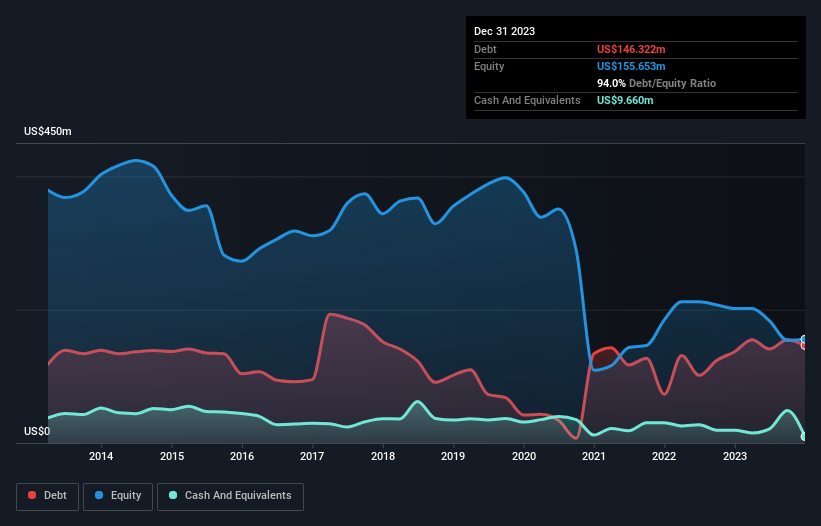David Iben put it well when he said, 'Volatility is not a risk we care about. What we care about is avoiding the permanent loss of capital.' When we think about how risky a company is, we always like to look at its use of debt, since debt overload can lead to ruin. We can see that Tredegar Corporation (NYSE:TG) does use debt in its business. But the real question is whether this debt is making the company risky.
When Is Debt A Problem?
Generally speaking, debt only becomes a real problem when a company can't easily pay it off, either by raising capital or with its own cash flow. In the worst case scenario, a company can go bankrupt if it cannot pay its creditors. However, a more usual (but still expensive) situation is where a company must dilute shareholders at a cheap share price simply to get debt under control. Of course, debt can be an important tool in businesses, particularly capital heavy businesses. The first step when considering a company's debt levels is to consider its cash and debt together.
Check out our latest analysis for Tredegar
What Is Tredegar's Net Debt?
The image below, which you can click on for greater detail, shows that at December 2023 Tredegar had debt of US$146.3m, up from US$137.0m in one year. On the flip side, it has US$9.66m in cash leading to net debt of about US$136.7m.

How Strong Is Tredegar's Balance Sheet?
The latest balance sheet data shows that Tredegar had liabilities of US$249.1m due within a year, and liabilities of US$41.7m falling due after that. Offsetting these obligations, it had cash of US$9.66m as well as receivables valued at US$69.1m due within 12 months. So its liabilities outweigh the sum of its cash and (near-term) receivables by US$212.0m.
This deficit casts a shadow over the US$136.1m company, like a colossus towering over mere mortals. So we definitely think shareholders need to watch this one closely. After all, Tredegar would likely require a major re-capitalisation if it had to pay its creditors today. The balance sheet is clearly the area to focus on when you are analysing debt. But you can't view debt in total isolation; since Tredegar will need earnings to service that debt. So when considering debt, it's definitely worth looking at the earnings trend. Click here for an interactive snapshot.
In the last year Tredegar had a loss before interest and tax, and actually shrunk its revenue by 25%, to US$703m. That makes us nervous, to say the least.
Caveat Emptor
Not only did Tredegar's revenue slip over the last twelve months, but it also produced negative earnings before interest and tax (EBIT). Its EBIT loss was a whopping US$16m. When we look at that alongside the significant liabilities, we're not particularly confident about the company. It would need to improve its operations quickly for us to be interested in it. Not least because it burned through US$2.5m in negative free cash flow over the last year. That means it's on the risky side of things. There's no doubt that we learn most about debt from the balance sheet. However, not all investment risk resides within the balance sheet - far from it. For instance, we've identified 2 warning signs for Tredegar that you should be aware of.
At the end of the day, it's often better to focus on companies that are free from net debt. You can access our special list of such companies (all with a track record of profit growth). It's free.
Valuation is complex, but we're here to simplify it.
Discover if Tredegar might be undervalued or overvalued with our detailed analysis, featuring fair value estimates, potential risks, dividends, insider trades, and its financial condition.
Access Free AnalysisHave feedback on this article? Concerned about the content? Get in touch with us directly. Alternatively, email editorial-team (at) simplywallst.com.
This article by Simply Wall St is general in nature. We provide commentary based on historical data and analyst forecasts only using an unbiased methodology and our articles are not intended to be financial advice. It does not constitute a recommendation to buy or sell any stock, and does not take account of your objectives, or your financial situation. We aim to bring you long-term focused analysis driven by fundamental data. Note that our analysis may not factor in the latest price-sensitive company announcements or qualitative material. Simply Wall St has no position in any stocks mentioned.
About NYSE:TG
Tredegar
Through its subsidiaries, manufactures and sells aluminum extrusions, and polyethylene and polypropylene plastic films in the United States and internationally.
Excellent balance sheet with questionable track record.
Similar Companies
Market Insights
Community Narratives



